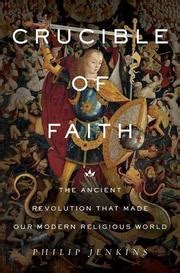Philip Jenkins has produced an interesting work, Crucible of Faith: The Ancient Revolution that Made our Modern Religious World, Basic Books, NY (2017)
His thesis is that: “So much of what we think of as the Judeo-Christian spiritual universe was conceived and described only after the closure of the canonical Old Testament text. Virtually every component of that system entered the Jewish world in the two or three centuries before the Common Era, and we can identify a critical moment of transformation around the year 250″ BC. (xiv)
He states that “It was in these years when the heavens and hell became so abundantly populated and when the universe was first conceived as a battleground between cosmic forces of Good and Evil.” (xiv-xv)
He traces the movement of these themes from Jewish religion into Christianity and then into Islam, so that these ideas are now: “the shared cultural inheritance of well over half the world’s people.” (xv) Jenkins says that this all occurred in what he calls a “crucible ages” from about 250 to 50 BC (He uses BCE but I use, BC – this idea of a “common era” is just nonsense – we happen to discover that a common era began exactly where AD begins?).
Jenkins says that Western consciousness was forged at this time. He continues:
“The growth of pure monotheism during the seventh and six centuries” BC “raised troubling questions about the means by which God could act in history. Monotheism created an intellectual need for intermediary figures who enacted the divine will in his stead, and that necessitated a fast growing belief in the reality in power of angels. Meanwhile, attempts to explain the existence of evil in a divinely ordered system inspired an obsessive interest in dark angels and in Satan himself. The need to see justice in the divine order inspired a vital new belief in concepts of the afterlife and resurrection, in ultimate rewards and punishments.” (xvi)
He later adds other ideas to this list, such as the development of that of the Christ, Scripture and changes in the nature of prophecy. What he says is always interesting, for example, on scripture, he writes:
“The movement toward text had potent political implications. As Protestant Christians have long known, a book-based faith is likely to be both diverse and sectarian. … This [reading] increased the likelihood of sectarian division, as different groups read scripture differently. They found independent justifications and interpretations and wrote their own religious texts.” (21) He notes, too, that the NT quoted the OT in the Greek of the Septuagint (40), although I think some scholars would qualify this.
One of the more interesting chapters concerns the growth of Wisdom literature. I have always thought that this literature, especially as more fully retained in the Greek OT, is one of the great signs that God was preparing the world for the Incarnation.
I am not convinced that the age he refers to had all the characteristics he would attribute to it, and I think he may understate how much it owed to previous developments. He also seems to miss the extent to which what was revealed then were truths, such as the existence of Purgatory. But still, it is valuable to consider the way God primed the Jewish people for the coming of their Messiah, and how the greatest “crucible of faith” of all lay in the person and teaching and actions of Christ Jesus.
